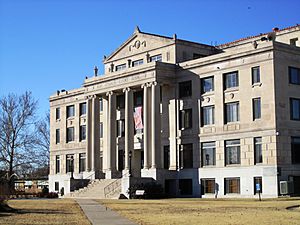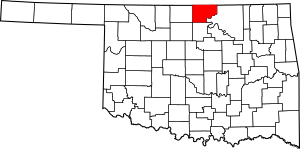Kay County, Oklahoma facts for kids
Quick facts for kids
Kay County
|
|
|---|---|

Kay County Courthouse in Newkirk (2010)
|
|

Location within the U.S. state of Oklahoma
|
|
 Oklahoma's location within the U.S. |
|
| Country | |
| State | |
| Founded | 1893 |
| Seat | Newkirk |
| Largest city | Ponca City |
| Area | |
| • Total | 945 sq mi (2,450 km2) |
| • Land | 920 sq mi (2,400 km2) |
| • Water | 25 sq mi (60 km2) 2.7%% |
| Population
(2020)
|
|
| • Total | 43,700 |
| • Density | 46.24/sq mi (17.855/km2) |
| Time zone | UTC−6 (Central) |
| • Summer (DST) | UTC−5 (CDT) |
| Congressional district | 3rd |
Kay County is a county located in the U.S. state of Oklahoma. As of the 2020 census, its population was 43,700. Its county seat is Newkirk, and the largest city is Ponca City.
Kay County comprises the Ponca City micropolitan statistical area. It is in north-central Oklahoma on the Kansas state line.
Before statehood, Kay County was formed from the "Cherokee Strip" or "Cherokee Outlet" and originally designated as county "K". Its name means simply that. Kay County is the only county to keep its same name as the Oklahoma area moved from a territory to a state.
Contents
History
The remains of two large 18th-century villages, the Deer Creek/Bryson Paddock Sites, of Wichita Native Americans have been found overlooking the Arkansas River in Kay County. The Osage used Kay County for hunting in the late 18th and early 19th centuries. In 1825, the Osage ceded to the U.S. government their rights to a large expanse of land, including Kay County, and the government gave the Cherokee ownership of the land after their migration to Oklahoma in the 1830s.
After the Civil War, the Cherokee Nation was forced to allow the federal government to relocate other Native American tribes to settle in the area known as the Cherokee Outlet. The Kansa (Kaw) arrived in June 1873, settling in what became the northeastern part of Kay County. The Ponca followed in 1877. The Nez Perce came from the Pacific Northwest in 1879, but remained only until 1885, when they returned to their earlier homeland. Their assigned land in Oklahoma was then occupied by the Tonkawa and Lipan Apache peoples. Most of Kay County became open to non-Native American settlement in 1893 with the Cherokee Strip Land Run in which thousands of people rushed into Kay County to claim free land.
The Chilocco Indian Agricultural School, north of Newkirk, was a boarding school for Indians that operated from 1884 to 1980. Its enrollment peaked at 1,300 in the 1950s and its graduates include members of 126 Indian tribes. The distinguished old buildings of the school were constructed of local limestone.
In 2010, the Keystone-Cushing Pipeline (Phase II) was constructed north to south through Kay County to Cushing in Payne County.
On September 17, 2024, the National Park Service announced that Kay County and Ponca City were jointly named a World War II Heritage City.
Geography
According to the U.S. Census Bureau, the county has a total area of 945 sq mi (2,450 km2), of which 25 square miles (65 km2) (2.7%) are covered by water. The highest point in Kay County, Oklahoma, is west of North Sage Lane (36′56″12°N, 96′53″40°W), at 1,310 feet (400 m) above sea level. The lowest point is 891 feet (272 m) where the Arkansas River leaves the county.
The northern boundary is the border with Kansas and its eastern boundary is with Osage County. Kaw Lake, a large reservoir on the Arkansas River completed in 1975 includes most of the water area of the country. East of Kaw Lake and the Arkansas River is the region called the Osage Hills or The Osage, a tall-grass prairie region of large livestock, mostly cattle, ranches. West of the Arkansas River the land is flatter and a mixture of cultivated lands and livestock ranches. Principal rivers flowing through the county are the Chikaskia River, the Arkansas River and the Salt Fork of the Arkansas River.
Major highways
Adjacent counties
- Cowley County, Kansas (north)
- Garfield County (southwest)
- Grant County (west)
- Noble County (south)
- Osage County (east)
- Sumner County, Kansas (north)
Demographics
| Historical population | |||
|---|---|---|---|
| Census | Pop. | %± | |
| 1900 | 22,530 | — | |
| 1910 | 26,999 | 19.8% | |
| 1920 | 34,907 | 29.3% | |
| 1930 | 50,186 | 43.8% | |
| 1940 | 47,084 | −6.2% | |
| 1950 | 48,892 | 3.8% | |
| 1960 | 51,042 | 4.4% | |
| 1970 | 48,791 | −4.4% | |
| 1980 | 49,852 | 2.2% | |
| 1990 | 48,056 | −3.6% | |
| 2000 | 48,080 | 0.0% | |
| 2010 | 46,562 | −3.2% | |
| 2020 | 43,700 | −6.1% | |
| U.S. Decennial Census 1790-1960 1900-1990 1990-2000 2010 |
|||
As of the census of 2000, there were 48,080 people, 19,157 households, and 13,141 families residing in the county. The population density was 52 people per square mile (20 people/km2). There were 21,804 housing units at an average density of 24 units per square mile (9.3/km2). The racial makeup of the county was 84.16% White, 1.79% Black or African American, 7.53% Native American, 0.53% Asian, 0.02% Pacific Islander, 1.98% from other races, and 4.00% from two or more races; 4.25% of the population were Hispanic or Latino of any race. In 2020, its population was 43,700.
As of 2000, there were 19,157 households, out of which 31.90% had children under the age of 18 living with them, 54.70% were married couples living together, 10.20% had a female householder with no husband present, and 31.40% were non-families. 27.90% of all households were made up of individuals, and 13.10% had someone living alone who was 65 years of age or older. The average household size was 2.45 and the average family size was 2.99. In the county, the population was spread out, with 26.40% under the age of 18, 8.80% from 18 to 24, 25.00% from 25 to 44, 22.80% from 45 to 64, and 17.00% who were 65 years of age or older. The median age was 38 years. For every 100 females there were 93.70 males. For every 100 females age 18 and over, there were 89.90 males.
In 2000, the median income for a household in the county was $30,762, and the median income for a family was $38,144. Males had a median income of $30,431 versus $19,617 for females. The per capita income for the county was $16,643. About 12.40% of families and 16.00% of the population were below the poverty line, including 22.70% of those under age 18 and 9.50% of those age 65 or over. In 2021, its median household income was $50,391.
Communities
Cities
- Blackwell
- Kaw City
- Newkirk (county seat)
- Ponca City (largest city) (partially in Osage County)
- Tonkawa
Towns
Census-designated places
Other unincorporated community
- Chilocco
Notable people
- Joseph James, Mixed-blood Kaw native American, died in Kay County in 1898.
- Les Layton, baseball player.
- Jim Reese, former member of the Oklahoma House of Representatives and since 2011 the commissioner of the Oklahoma Department of Agriculture, was born in Kay County c. 1957.
- E.W. Marland, 10th Governor of Oklahoma, U.S. Congressman, and Oil tycoon who gained and lost a fortune in the Oklahoma oil fields.
- The Miller Brothers - Joseph, George and Zack - who inherited the famous 101 Ranch from parents G.W. and Molly Miller, who encouraged their children to go big or go home.
- Lew Wentz - oil tycoon and philanthropist
See also
 In Spanish: Condado de Kay para niños
In Spanish: Condado de Kay para niños

